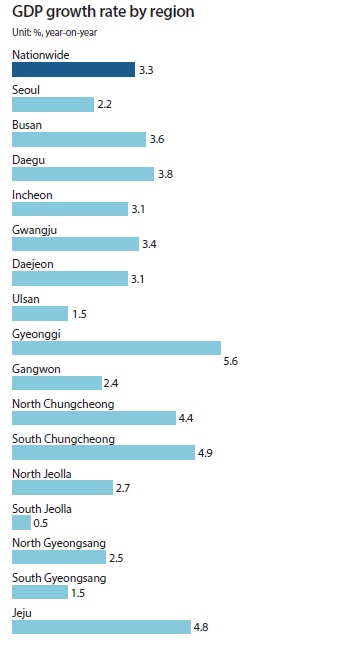Gyeonggi last year overtook Seoul in terms of regional economy for the first time since 1998, when the government started gathering data.
According to Statistics Korea on Tuesday, Gyeonggi’s GDP in 2014 was the largest, at 329 trillion won ($279 billion). Seoul trailed closely behind with 328 trillion won. The smallest region was Jeju, where the economy was only 14 trillion won.
The study also showed that the nation’s economy was mostly concentrated in the greater Seoul area, as the three regions, including Seoul, Gyeonggi and Incheon, accounted for 48.9 percent of the country’s total GDP. This is 0.2-percentage point increase from the previous year, when the regions accounted for 48.7 percent.
On average, the cities and provinces reported a growth of 3.3 percent.
“Seoul’s economy largely consists of service and retail businesses, and these sectors showed stagnant growth last year,” said Eo Woon-sun, director of income statistics at Statistics Korea. “On the other hand, Gyeonggi’s economy mostly involves manufacturing and construction, and these sectors performed well.”
Although by size Jeju was last, the region saw significant growth thanks to a growing tourist population and foreign direct investment from China.
BY KIM JI-YOON


![Samsung to unveil latest foldable smartphones at Galaxy Unpacked 2025 in New York A teaser image of Samsung Electronics' latest foldable smartphones [SCREEN CAPTURE]](https://www.koreadailyus.com/wp-content/uploads/2025/06/0624-Samsung-218x150.jpg)
![U.S. places South Korea back on currency watchlist U.S. Secretary of the Treasury Scott Bessent speaks to reporters before walking into the White House in Washington, United States, March 13. [REUTERS]](https://www.koreadailyus.com/wp-content/uploads/2025/06/0606-treasury-218x150.jpg)
![Czech Republic finalizes $18B nuclear power contract with South Korea, overcoming French opposition Cooling towers operating at the Dukovany nuclear power plant operated by CEZ AS, near the village of Dukovany, Czech Republic, on May 6, 2025 [Lim Sung-bin]](https://www.koreadailyus.com/wp-content/uploads/2025/06/0604-Cech-218x150.jpg)



